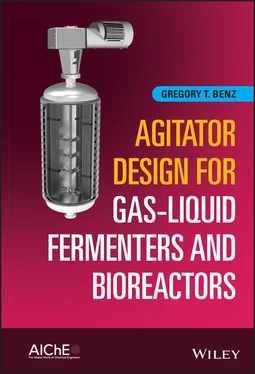Gregory T. BenzBenz Technology International, Inc.
Genetic modification, microbiome, green technology, renewable fuels and chemicals, bio‐degradable plastic, pandemic recovery, prebiotics, probiotics, agricultural biologics, world food shortage, meatless meat, animal free dairy, human and animal health. What do these important concepts have in common? They all rely on the use of bioreactors to realize the ultimate benefit to current and future generations.
The most powerful of these products utilized in human and animal health can generate the world supply in quantities measured in pounds. Vaccines, antibiotics, probiotics, prebiotics, and others have a large portion of their cost included in research and development, clinical trials, and regulatory approval processes that bring challenge to this business space. In these cases, the bioreactors capital and operational cost impact to the cost of goods sold is small compared to the margins and returns of a successful product launch. These applications historically required a focus on agitation and reactor design with a focus on functionality versus a minimization of operating cost. These products are apportioned in quantities measured in microgram to gram quantities with price measured in millions of dollars per pound in some cases.
On the other end of the spectrum are commodity products utilized every day in quantities measured in tens to hundreds of millions of tons per year. Fuel, polymers, industrial chemicals, animal feed ingredients, and the like. These products’ sales prices are measured in pennies to dollars per pound and operate on tight margins. Making these products in bioreactors is more challenging as a result requiring a focus on things such as reactor design, power optimization between the agitator and air compressor can be a competitive advantage or define the success or failure of a venture.
The teams I worked with directly had the pleasure of working with Greg Benz for the past 15 years on commodity products. From development to commercialization, the details of reactor design mattered significantly in these projects. The information provided in this book allowed the proper questions to be asked during process design. Bench, pilot, and demonstration trials were designed to be commercially applicable as a result. This allowed for realistic process design, rate, titer, and yield demonstrations to be applied to financial and process modeling early in the process. It also prevented mistakes that saved hundreds of thousands of dollars through effective understanding prior to spending significant development dollars.
Our team worked with the smallest start‐ups to the largest most established biotech companies in the world as a contract research and manufacturing operation. Each time agitation questions are asked, Greg is the go‐to expert that everyone already knows and has positive experiences with. Greg’s knowledge and experience in this area is of significant importance to realizing the benefit of modern biological technology. I am happy to see that he has decided to put his knowledge and experience in a more detailed writing as I have referenced his course materials hundreds of times in the past 15 years. Thank you to Greg, the biotechnology industries favorite “Professional Agitator.”
Jeremy Javers PhDSt. Joseph, MO1 September 2020
Bioreactor agitator engineering is a broad mosaic. The image is simple and clear from a distance, but as the viewer moves closer, a multitude of distinct individual pieces come into view. Likewise, several diverse disciplines converge in this specialized field: microbiology, transport phenomena, machine design, metallurgy, and reliability engineering. During a project, this list is expanded to include manufacturing and procurement. For the practitioner, the challenge is significant. What information is important? What solutions are time‐tested? What are the common pitfalls? How should all of these pieces be assembled into a unified design?
There are many books and articles available on the design of agitators and bioreactors. However, when the time comes to prepare drawings and make purchases for an actual project, it becomes apparent that those resources are missing large swaths of practical information to guide the reader’s design choices. How are bioreactor agitators designed in real life? This comprehensive book addresses both the broad background and the small details needed to deliver a good project, from design through delivery.
I was excited to learn that Greg Benz was writing this book. We have worked together for many years designing equipment for bioprocessing facilities, from cellulosic ethanol to enzyme production to hydrogen‐rich gas fermentation. He has been a trusted mentor and a patient teacher.
Greg is an accomplished practitioner, a true craftsman. His career has spanned the full scope of the design, manufacturing, and operation of mixing systems, with a special focus on gas–liquid systems for bioreactors. Through his years at Chemineer, and later as a well‐known and respected mixing consultant, he has perhaps overseen more bioreactor agitator designs than anyone in the field. His expertise helped to establish industrial biotechnology as a mature industry.
During our years working together, Greg has offered insight on many questions not generally answered in fermentor design books, such as: What is the best way to seal a shaft? What is better: small, fast agitators or big and slow? What are the most common failure modes? Is metal surface polishing really necessary in comparison with other contamination sources? How much polish? What are the most common failure modes? How much overdesign should be included? Bubble columns versus stirred tanks? What are the latest innovations? How does fed‐batch impact agitation design? What information should we gather at pilot scale to ensure commercial‐scale success? How should the fermenter be controlled to maintain a dissolved oxygen level: vary the air or vary the motor speed? How do agitation performance and power draw change if the mixer is on speed control? How are baffles designed? How do we clean underneath an impeller? How can thermal expansion be handled during cleaning and steam‐in‐place? What heat transfer coefficient should we expect from internal coils? External jackets? What vendors are reliable? How do we install this equipment, anyway?
Until now, answers to these questions have been difficult to find, making this book a treasure trove for a practicing engineer. Additionally, this valuable information will fuel the progress of biotechnology, which provides food and energy resources to people around the world.
Few engineers possess Greg's wealth of expertise and fewer still take the time to meticulously summarize their knowledge for the benefit of future generations. That he did so makes me very glad.
Keith Flanegan, P.E.IdeaCHEM, Inc.September 2020
1 Purpose of Agitator Design
The purpose of using the agitator design principles in this book is to ensure, to the extent possible, that the user of agitation equipment achieves the process objectives and does so in a reliable and economical manner.
Agitators are employed in many different industries. The process results/objectives desired from the agitators vary by industry and by application within each industry. Since an agitator is ultimately nothing more than a kind of pump, and the agitated tank is essentially a deadheaded pump, it would be ideal if the objectives could be stated in purely physical terms, mostly related to flow and head. For example, some would describe agitation in terms of pumping capacity, characteristic fluid velocity [1], G‐value [2], or other physical terms.
Читать дальше












